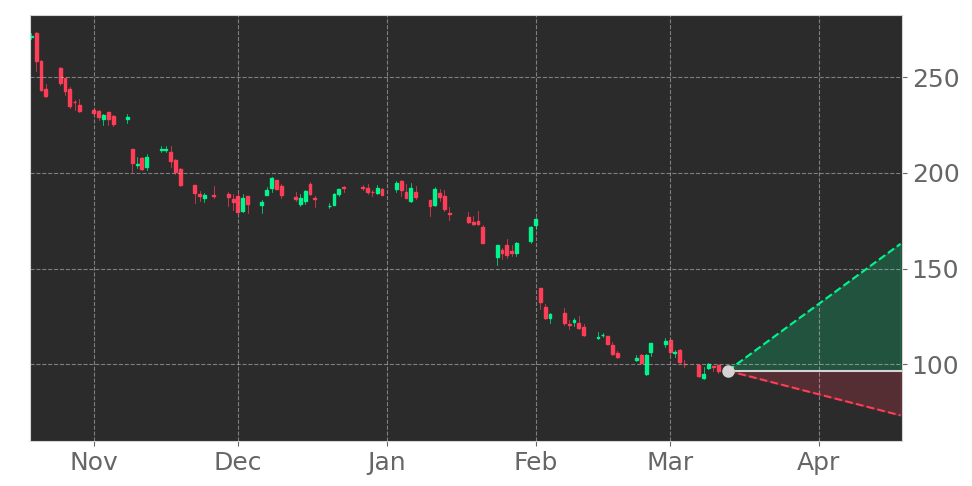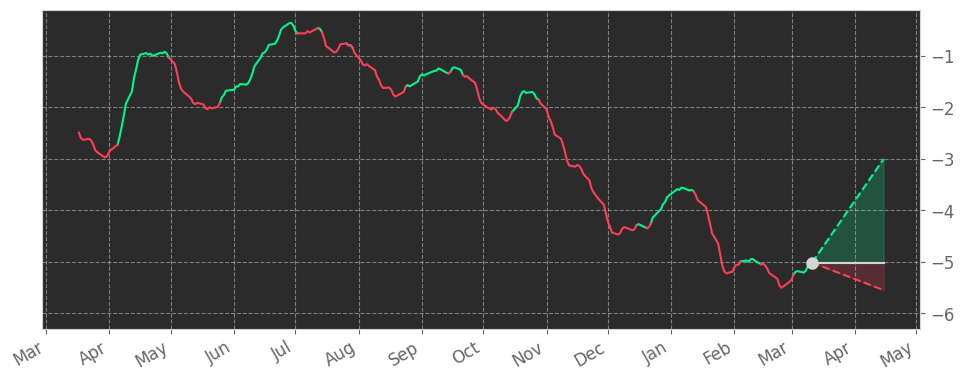Moving higher for three straight days is viewed as a bullish sign. Keep an eye on this stock for future growth. Considering data from situations where PYPL advanced for three days, in 269 of 361 cases, the price rose further within the following month. The odds of a continued upward trend are 75%.
The RSI Indicator points to a transition from a downward trend to an upward trend -- in cases where PYPL's RSI Oscillator exited the oversold zone, 12 of 18 resulted in an increase in price. Tickeron's analysis proposes that the odds of a continued upward trend are 67%.
The Stochastic Oscillator shows that the ticker has stayed in the oversold zone for 4 days. The price of this ticker is presumed to bounce back soon, since the longer the ticker stays in the oversold zone, the more promptly an upward trend is expected.
The Moving Average Convergence Divergence (MACD) for PYPL just turned positive on February 25, 2022. Looking at past instances where PYPL's MACD turned positive, the stock continued to rise in 34 of 48 cases over the following month. The odds of a continued upward trend are 71%.
PYPL may jump back above the lower band and head toward the middle band. Traders may consider buying the stock or exploring call options.
Bearish Trend Analysis
Following a 3-day decline, the stock is projected to fall further. Considering past instances where PYPL declined for three days, the price rose further in 50 of 62 cases within the following month. The odds of a continued downward trend are 60%.
The Aroon Indicator for PYPL entered a downward trend on March 11, 2022. This could indicate a strong downward move is ahead for the stock. Traders may want to consider selling the stock or buying put options.
Fundamental Analysis (Ratings)

The Tickeron Price Growth Rating for this company is 66 (best 1 - 100 worst), indicating fairly steady price growth. PYPL’s price grows at a lower rate over the last 12 months as compared to S&P 500 index constituents.
The Tickeron SMR rating for this company is 69 (best 1 - 100 worst), indicating weak sales and an unprofitable business model. SMR (Sales, Margin, Return on Equity) rating is based on comparative analysis of weighted Sales, Income Margin and Return on Equity values compared against S&P 500 index constituents. The weighted SMR value is a proprietary formula developed by Tickeron and represents an overall profitability measure for a stock.
The Tickeron Profit vs. Risk Rating rating for this company is 73 (best 1 - 100 worst), indicating that the returns do not compensate for the risks. PYPL’s unstable profits reported over time resulted in significant Drawdowns within these last five years. A stable profit reduces stock drawdown and volatility. The average Profit vs. Risk Rating rating for the industry is 80, placing this stock better than average.
The Tickeron PE Growth Rating for this company is 85 (best 1 - 100 worst), pointing to worse than average earnings growth. The PE Growth rating is based on a comparative analysis of stock PE ratio increase over the last 12 months compared against S&P 500 index constituents.
The Tickeron Valuation Rating of 92 (best 1 - 100 worst) indicates that the company is significantly overvalued in the industry. This rating compares market capitalization estimated by our proprietary formula with the current market capitalization. This rating is based on the following metrics, as compared to industry averages: P/B Ratio (5.179) is normal, around the industry mean (4.244). P/E Ratio (27.397) is within average values for comparable stocks, (17.394). Projected Growth (PEG Ratio) (0.985) is also within normal values, averaging (1.135). PYPL has a moderately low Dividend Yield (0.000) as compared to the industry average of (0.034). P/S Ratio (4.515) is also within normal values, averaging (47.707).
Comments